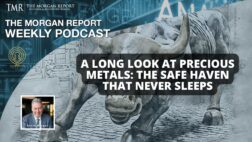The Mining Footprint – A Bullish Gold and Silver Driver
by David H. Smith
In print and during speeches to large audiences, David Morgan states the truism that “everything we use in our modern-day lives is either grown or mined”. These two pursuits pretty much de?ne what it takes to survive and thrive in the modern world. And how we go about conducting these activities has a direct bearing, not only on us today, but for future generations as well.
The production of precious and base metals presents a certain amount of environmental risk between the time they are dug out of the ground, to when they are sent to industrial applications or end up in the palm of your hand. Seldom found near the surface, gold and silver ore must be blasted, dug, and transferred out of narrow passageways, often hundreds, if not thousands of feet below the surface – then processed by one of two primary methods.
Transported to a mill, the ore undergoes a crushing – ?otation circuit process whereby the majority of the metals’ containing deposit is separated from the Iby David H. Smithremaining rock, usually by chemical and aeration operations, yielding concentrate or “con”. This relatively dry, high-value powdery residue is trucked to a smelter and re?ned into “dore” bars of 60 – 80% purity. Finally, it undergoes specialized processing to achieve the .999 ?ne level associated with the bullion/legal tender coins, bars or medallions of which the public is familiar.
Another process – heap leaching – harvests metal from low-grade deposits, involving the processing of a lot of rock. A ton of crushed ore may yield only a fraction of an ounce of gold or a hundred grams of silver! The ore is stacked on lined pads and sprayed with chemicals, in order to “leach” metal from the surrounding waste material. Ore thus obtained comes either from open pit excavation, or the previously-described underground mine source.The thick liquid tailings left after processing – with various levels of toxicity – are stored in “tailings ponds”, which over time may become solid earth. In some hilly parts of Mexico having little ?at ground, a hardened tailings pond may be covered over with earth and used as a soccer ?eld! But in larger operations, these ponds can take many years – if ever – to fully dry out, since a large operation continually adds liquid residue. If the pond walls are not built properly – or even if they are, and if they become subject to shifting ground, a ?ash ?ood, or some other destabilizing event, they may leak – or collapse.
This is what happened recently in British Columbia, with a variation on the theme a short time later in Mexico. In the B.C. case, reportedly several billion gallons of treated water of questionable toxicity ?ooded into a nearby lake and surrounding streams. While it will take some time to measure the full effects, the negative impact on the public’s perception of mining and the risks it entails was immediate and likely will be long-lasting.
Read rest of article here…
http://goo.gl/9vMYmp
David Morgan is a precious metals aficionado armed with degrees in finance and economics as well as engineering, he created the Silver-Investor.com website and originated The Morgan Report, a monthly that covers economic news, overall financial health of the global economy, currency problems, and the key reasons for investing in precious metals.
As publisher of The Morgan Report, he has appeared on CNBC, Fox Business, and BNN in Canada. He has been interviewed by The Wall Street Journal, Futures Magazine, The Gold Report and numerous other publications. If there is only one thing to teach you about this silver bull market it is this… 90% of the move comes in the last 10% of the time! Where will you be when this happens?
Offer does not apply to Premium Memberships.



